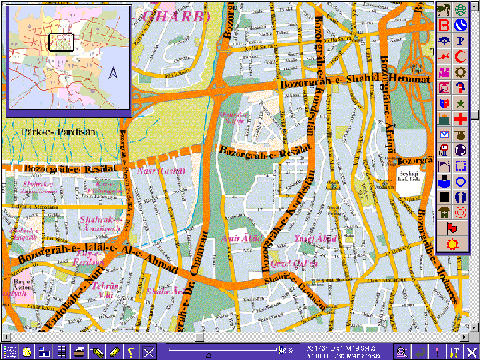TEHRAN'S usa-RED BRICK WALL
by
JOHN PAHLE

You’ll
see it sometimes on a television news report, and while they
usually use the same footage -- angry chanting students, hand-lettered
anti-American signs -- the backdrop doesn’t change. Although
the brick walls still stand of what once was the American Embassy
in Tehran, Iran, the video never quite captures its deep red:
burnt cherry, like crayon that stays sharp in the box, too dark
for anyone’s taste.
Senses are arbitrarily selective: three decades later, prompted
only by a glimpse of the wall on TV, Tehran’s dusty, diesel
fumes can still, like a city-sized gas station, pollute and
perfume the air in my living room. That wall kept the Iranians
out, yes, but Iran still found its way in: calls to prayer shrieked
five times a day, an alien cacophony to a nine-year-old’s
ears; double-decker buses -- only the top deck appearing to
glide by -- peered over the wall’s grey concrete top.
Honking taxis above a constant rumble of traffic. Steel cranes
whining and turning, accompanied by pounding jackhammers, relentless
construction in an ancient city determined by its leader to
be made new. Between all that and me the wall stood, an ivy-festooned
border.
You’re out there, it decreed. The United
States is in here.
Behind the front gate’s black metal bars, guarded by clean-faced
young marines, the embassy was figuratively and legally a piece
of America, redolent with spies and privilege: an ambassador
represented our president. Bell helicopters, thudding over Tehran
without respite, represented our industry. Even the embassy’s
buildings and streets were American; familiar -- comforting,
even -- to me. It was quiet. It was orderly. It looked nothing
like the bazaar that was downtown Tehran. The signs were in
English, the cars were American. Between the swimming pool and
the supermarket were fields, trimmed shrubbery, people who looked
like my parents.
People who looked like me.
How easy, then, it was to look at those deep red bricks with
relief, as they kept out the dark and scary Iranians, foreign
to me in their own country. Strangers whose alien language made
as much sense as the barks of the stray dogs who ran in packs
near my school, whose mosques and minarets seemed to have fallen
from Mars. Whose signs curlicued and lied to me in indecipherable
calligraphy. Fear charged with resentment turned a nine-year-old
into a budding imperialist. No, I knew that wall kept me safe.
I worried about unguarded gates in back, spots where the wall
could be bounded, breached. That wall, after all, stood between
me and the natives, between Wonder Bread and noon,
between American steaks and goat, goat often sacrificed in the
streets annually at the Eid.
There were interlopers inside. Iranian drivers and janitors
who drank tea the way their ancestors in desert caravansaries
did -- dipping sugar cubes in tea and chewing the crunchy, sweetened
mess. They were part of the embassy, true, but not of it. The
wall for them was something that contained them for a day. They
could leave in the evening, but I was there, trapped in Iran,
becoming, against the will of a boorish child, gradually steeped
in its culture, its history. Iranian politics were real, its
politics were lived. While Nixon’s photo was replaced
by Ford’s, and later by Carter’s, the oil paintings
of Reza Shah Pahlavi, Shahanshah -- King of Kings, His Imperial
Highness, remained.
But when the angry new met the entrenched old
-- the way two storm fronts meet on the Great Plains, leaving
tornadoes and floods in their wake -- and when the Iranians
tired of His Imperial Highness, of his secret SAVAK police,
of Bell helicopter, of the CIA, of the red brick walls of the
embassy itself, and they took to the streets, the world changed
for me. Martial law. Gunshot staccato at night. Sleeping under
bed frames, listening to no news save what we could pick up
on the BBC over short-wave. Revolution. Finally an early-morning
747 evacuation as Iran fell into pieces.
Memories are arbitrary; perspectives change. Thirty years later,
I still see the wall -- whether on the television or in my mind’s
unsteady photographs -- but it seems to have changed its purpose.
No longer is it keeping out the foreign. Now it’s encircling
me, holding me among the sheltered, the familiar, all as certain
and as secure as my middle-aged gut.
True, I’m looking back through a sentimental haze, of
course. Most of us remember childhood wistfully. Who wouldn’t
like a second chance? But that wall is still there, taunting
me. On its other side is another world, one lost to me, perhaps
forever. Another language, an architecture and a people reminiscent
of A Thousand and One Nights. Far from condescension,
I envy it. I crave signs that can’t be read, an atonal
music heard as if hearing song for the first time, a language
to which I have to strive to listen, to understand.
People who look nothing like me.
As reports of strife in the Middle East change to another topic
on the nightly news, and the video footage shows new hot spots
and more important politicians, the wall and its deep red bricks
disappear from my television screen. I am comforted. I know
that I am safe, I know I am protected from the alien and strange,
and, thus reassured, I think about that wall and examine it
closely for cracks, chinks -- those gaps through which I once
feared the outsiders would invade, and I look for a way out.